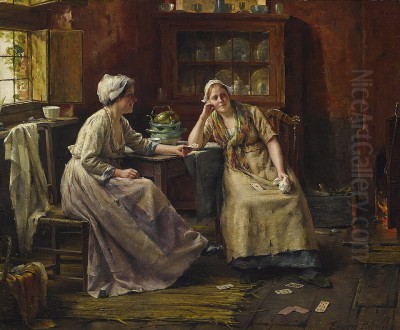
Edward Antoon Portielje stands as a significant figure in Belgian art history, particularly noted for his sensitive and detailed depictions of domestic life in the late 19th and early 20th centuries. Born into an artistic family in Antwerp, Portielje carved a niche for himself as a master of genre painting, blending Realism with a subtle Romantic sensibility. His works offer a window into the quiet moments and daily routines of primarily female subjects, rendered with technical precision and a warm, inviting atmosphere.
Portielje's life spanned a period of considerable change in Europe, yet his art often focused on the enduring aspects of personal life and traditional settings. He captured the textures of fabrics, the play of light in interiors, and the unspoken narratives within seemingly simple scenes. His paintings were popular during his lifetime and continue to be appreciated by collectors and art enthusiasts for their charm, craftsmanship, and historical insight.
Early Life and Artistic Formation
Edward Antoon Portielje was born in the bustling port city of Antwerp, Belgium, on February 8, 1861. Artistry was deeply ingrained in his family background. His father was the well-regarded portrait and genre painter Jan Frederik Pieter Portielje (often known simply as Jan Portielje), and his mother was Eulalie Lemaire. Edward was not the only son to follow in his father's footsteps; his older brother, Gerard Jozef Portielje, also became a painter, specializing in similar genre themes.
Growing up in such an environment undoubtedly provided Edward with early exposure to the world of art and likely his initial encouragement. He formalized his training by enrolling at the prestigious Antwerp Royal Academy of Fine Arts (Koninklijke Academie voor Schone Kunsten van Antwerpen). This institution was a cornerstone of artistic education in Belgium, nurturing generations of talented artists.
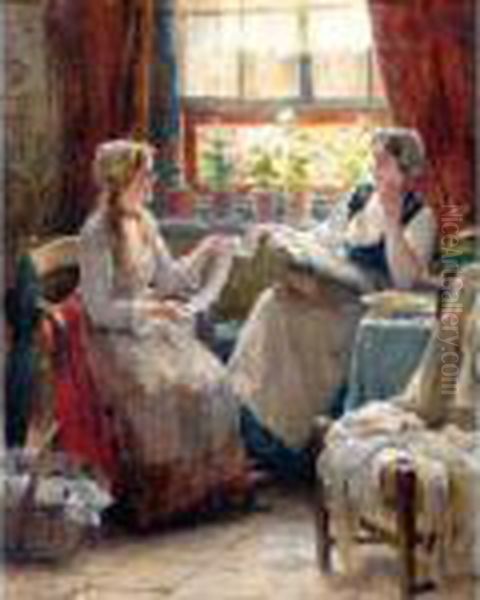
During his time at the Academy, Portielje studied under several influential figures. Among his teachers were Charles Verlat, a prominent painter known for his historical scenes, animal paintings, and portraits, and Nicaise De Keyser, a leading figure of the Belgian Romantic school, celebrated for his large-scale historical canvases and portraits. Sources also mention P. Beuvingh as one of his instructors, contributing to the solid technical foundation evident in Portielje's later work. His education focused on various aspects of painting, including an early interest in landscapes and seascapes, particularly scenes related to the fishing communities of Zeeland.
Artistic Style and Thematic Focus
Edward Antoon Portielje developed a distinctive style characterized by a meticulous realism softened by a gentle, often romantic, atmosphere. He primarily worked as a genre painter, focusing on scenes of everyday life, particularly those set within comfortable domestic interiors. His approach involved careful observation and a high degree of finish, paying close attention to details of clothing, furniture, and decorative objects.
His subjects were predominantly women, often depicted engaged in quiet, traditional activities. These included reading letters, sewing or lacemaking, enjoying a cup of tea, sharing confidences, or simply pausing in moments of reflection. Portielje seemed particularly drawn to capturing the intimate and tranquil aspects of bourgeois or traditional life. His figures are typically portrayed with a sense of calm and contentment, contributing to the overall warmth and charm of his compositions.
Light plays a crucial role in Portielje's paintings. He masterfully rendered the effects of natural light filtering through windows, illuminating specific areas of a room and highlighting textures. This use of light enhances the realism of the scene while also contributing to its mood, often creating a cozy and inviting ambiance. His color palette tends to be rich yet harmonious, further enhancing the visual appeal and emotional resonance of his work.
A recurring element in many of Portielje's paintings is the depiction of traditional costumes, particularly those associated with the Dutch province of Zeeland, which borders Belgium. This interest likely stemmed from his earlier focus on the region's fishing communities. The distinctive white bonnets, dark dresses, and aprons worn by his female figures add a specific cultural and historical context to his work, grounding the idealized domesticity in a recognizable regional identity. This focus on traditional attire also allowed him to showcase his skill in rendering different fabrics and textures.
Notable Works and Signature Scenes
Throughout his career, Edward Antoon Portielje created a substantial body of work, much of which revolves around his preferred themes of domestic intimacy. While a comprehensive catalogue is extensive, several paintings stand out as representative of his style and subject matter.
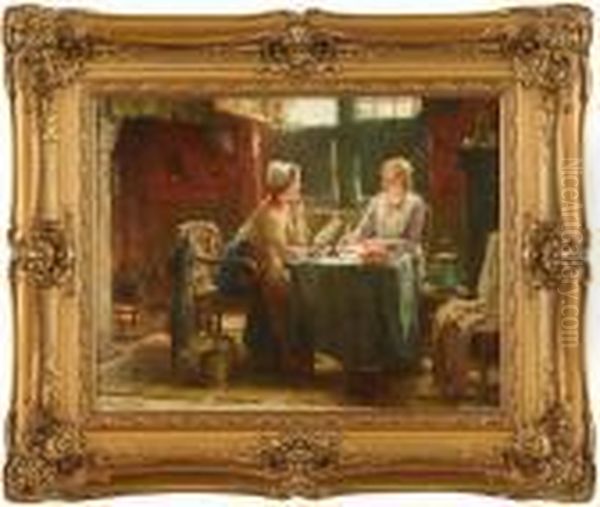
_Ladies Having Tea_ (or similar titles like _Afternoon Tea Time_, _Waiting_): Portielje frequently returned to the theme of women sharing tea. These paintings typically depict two or more women gathered around a table in a well-appointed interior. Works like these exemplify his skill in composing group figures, capturing subtle interactions, and rendering the details of porcelain teacups, silverware, and fashionable or traditional attire. The atmosphere is invariably one of relaxed sociability and quiet enjoyment, reflecting the importance of such rituals in contemporary social life.
_The Lacemakers_: This subject highlights another common domestic activity for women of the period. Portielje’s depictions of lacemakers often emphasize the concentration and skill involved in the craft, portraying the women absorbed in their delicate work. These scenes allowed him to explore themes of diligence and traditional craftsmanship, often set within simple yet warm interiors. The painting The Lacemakers mentioned in sources captures the "calm happiness" associated with such focused, traditional labor.
_Les ravaudeuses au bord de la mer_ (The Mending Women by the Sea): This title suggests a work possibly linking his interest in domestic crafts (mending) with his earlier focus on coastal or Zeeland life. It showcases his ability to place figures within a specific environment, combining genre elements with hints of landscape or seascape, demonstrating his observational skills regarding daily life in those communities.
Letter Reading/Writing Scenes: Many of Portielje's paintings feature women reading or writing letters, often with expressions suggesting anticipation, reflection, or shared secrets. These works tap into the emotional significance of correspondence in an era before instant communication, hinting at narratives of love, friendship, or family news. The intimate setting usually enhances the personal nature of the activity.
_Plagerijtje_ (Teasing/Playfulness): This title is associated with a mural panel Portielje created for the Antwerp World's Fair in 1894. While details of the specific image may be scarce, the title suggests a lighter, perhaps more narrative scene than his typical quiet interiors, showcasing his versatility in handling different moods and potentially larger formats for public display.
These examples illustrate Portielje's consistent focus on capturing the nuances of everyday life, particularly the experiences of women, through carefully constructed compositions, detailed rendering, and an emphasis on atmosphere and quiet emotion. His ability to elevate simple domestic moments into charming and enduring images is a hallmark of his artistic achievement.
Career, Exhibitions, and Recognition
Edward Antoon Portielje enjoyed a successful career, gaining recognition both within Belgium and internationally. While perhaps not seeking the limelight of the major Parisian Salons as aggressively as some contemporaries, his work found favor in various exhibition venues and among private collectors.
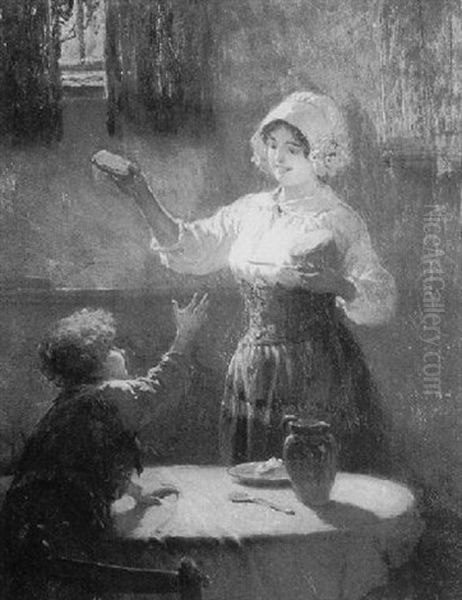
A significant moment in his public career was his participation in the Antwerp World's Fair (Wereldtentoonstelling) of 1894. He collaborated with fellow artists Ed. De Jans and J. Dierckx on a series of decorative panels or murals for the exposition. This commission indicates his standing within the Antwerp artistic community at the time. His contribution, including the panel titled Plagerijtje, was well-received, and sources suggest he was awarded a noble title (likely a knighthood or similar honor) in recognition of his work for the World's Fairs (possibly including contributions to the Ghent exposition as well).
Portielje regularly exhibited his paintings in Belgium. His works were shown at the Antwerp Museum (likely the Royal Museum of Fine Arts or exhibitions organized by local art societies) and in other major Belgian cities, including The Hague (though technically in the Netherlands, it was a common exhibition venue for Belgian artists), Namur, Mons, and Liège. He seemed to prefer these relatively smaller, yet often prestigious, national venues, cultivating a strong reputation within his home country.
His appealing style and relatable subject matter also attracted buyers beyond Belgium. His paintings were acquired by collectors across Europe and in the United States, demonstrating the broad appeal of his meticulously crafted genre scenes. The warmth, charm, and technical polish of his work made them desirable additions to private collections that favored traditional, representational art. The consistent demand for his paintings throughout his career attests to his success in connecting with the tastes of the time.
Artistic Context and Contemporaries
Edward Antoon Portielje worked during a vibrant period in Belgian art. The late 19th and early 20th centuries saw the continuation of strong academic traditions alongside the rise of new movements like Realism, Impressionism, Symbolism, and eventually early Modernism. Portielje firmly belonged to the tradition of Realist genre painting, albeit infused with a Romantic sensibility inherited from teachers like Nicaise De Keyser.
His most immediate artistic circle included his family: his father, Jan Frederik Pieter Portielje, whose own success in portraiture and genre likely influenced Edward's path, and his brother, Gerard Portielje, who worked in a similar vein. His teachers at the Antwerp Academy were significant figures: Charles Verlat, known for his versatility and robust style, and Nicaise De Keyser, a pillar of Belgian Romanticism and historical painting. De Keyser, despite his focus on grander themes, imparted a respect for technique and narrative that can be seen in Portielje's smaller-scale works. Another mentioned teacher was P. Beuvingh.
His collaborators on the World's Fair project, Ed. De Jans and J. Dierckx, were also part of the contemporary Antwerp art scene, working within the established representational modes suitable for large public commissions.
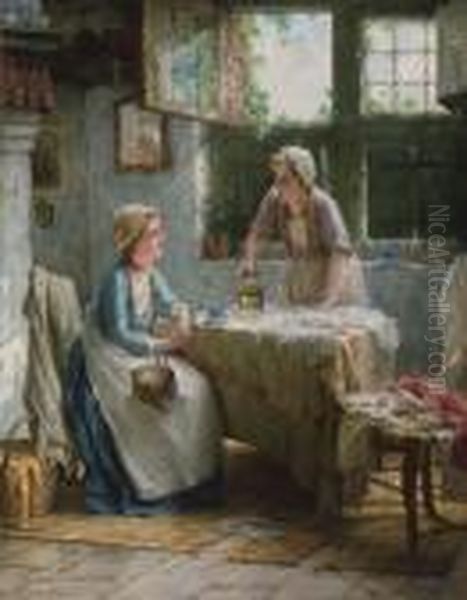
Beyond his direct connections, Portielje's work can be contextualized alongside other Belgian artists of the era. While his style differed, he was a contemporary of major figures who were exploring different artistic directions. James Ensor (1860-1949), born just a year before Portielje, became a leading figure of Symbolism and Expressionism, known for his masks and fantastical scenes. Fernand Khnopff (1858-1921) was another key Belgian Symbolist, exploring themes of mystery and introspection.
Closer to Portielje's focus on Realism and genre, one could consider Henri de Braekeleer (1840-1888), another Antwerp painter renowned for his intimate and atmospheric interior scenes, though often with a more melancholic or psychologically intense mood. Constantin Meunier (1831-1905) focused on Realist depictions of industrial workers, showcasing a different facet of contemporary Belgian life. Although primarily active in Paris, the Belgian painter Alfred Stevens (1823-1906) gained fame for his elegant portrayals of fashionable women in luxurious interiors, sharing Portielje's interest in female subjects and detailed settings, albeit usually more opulent.
The students of Portielje's teacher Nicaise De Keyser also formed part of the artistic landscape, including painters like Léon Abry (1857-1905), Aloïs Boudry (1851-1938), and Edgar Farasyn (1858-1938), who pursued various forms of Realism, portraiture, and genre painting, reflecting the enduring influence of academic training in Antwerp. Portielje operated within this rich and diverse artistic environment, adhering to a specific niche of detailed, charming genre painting that found a ready audience.
Legacy and Critical Evaluation
Edward Antoon Portielje's legacy rests on his consistent production of high-quality genre paintings that capture the spirit of domestic life in late 19th and early 20th-century Belgium. He is remembered as a skilled technician, capable of rendering textures, light, and detail with remarkable precision. His works are often praised for their warmth, charm, and the gentle, positive atmosphere they convey. Critics and collectors alike appreciated his ability to create visually pleasing and emotionally resonant scenes from everyday moments.
His paintings serve as valuable historical documents, offering insights into the clothing, customs, and interior decoration of the period, particularly concerning the lives of middle-class women and those in traditional communities like Zeeland. The focus on activities such as lacemaking, tea drinking, and letter reading reflects common pastimes and social rituals of the era. In this sense, his work contributes to the visual record of Belgian cultural history.
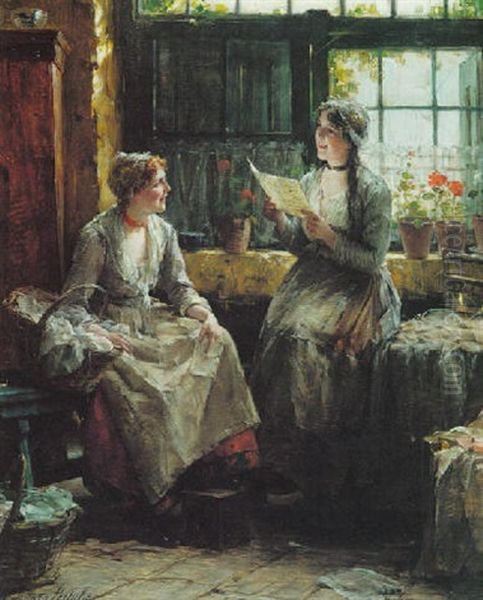
The market value of Portielje's work has remained relatively stable, with his paintings continuing to be sought after by collectors of traditional European genre art. Auction results, such as the mentioned estimate of $6,000-$8,000 for a work like Ladies Having Tea (though market values fluctuate), indicate ongoing interest. His popularity during his lifetime, particularly with European and American collectors, cemented his reputation.
While overwhelmingly positive, some modern critical perspectives might find his work somewhat idealized or sentimental, lacking the social critique or psychological depth found in the work of some Realist contemporaries like Constantin Meunier, or the avant-garde experimentation of figures like James Ensor. There might also be minor critiques, as noted in the source material, suggesting that an intense focus on detail could occasionally overshadow deeper emotional expression. However, this seems a minority view, as many appreciate the subtle emotions and narratives conveyed through his careful compositions and characterizations.
Overall, Edward Antoon Portielje is regarded as a master of his chosen genre. He excelled in creating intimate, beautifully executed paintings that celebrate the quiet virtues and simple pleasures of everyday life. His contribution lies in his ability to imbue these ordinary scenes with enduring charm and artistic merit.
Conclusion
Edward Antoon Portielje remains a respected and appealing figure in the history of Belgian art. As the son and brother of artists, and trained by leading figures at the Antwerp Academy, he was steeped in artistic tradition. He skillfully adapted this training to create a distinctive body of work focused on intimate domestic genre scenes. His paintings, characterized by meticulous detail, warm lighting, and sensitive portrayals of women in traditional or contemporary settings, captured a specific aspect of late 19th and early 20th-century life.
Through works depicting quiet moments of reading, crafting, or socializing, Portielje offered a vision of contentment and tranquility. His success in exhibitions and with collectors during his lifetime, coupled with the enduring appeal of his art, confirms his status as a significant chronicler of everyday life and a master craftsman within the Realist tradition. He died on December 18, 1949, leaving behind a legacy of charming and finely wrought paintings that continue to delight viewers today.